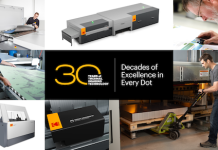MCC Verstraete has partnered with ECO3 and uses their Adamas plate technology. MCC Verstraete is a specialist in producing ‘in-mould labels’ (IMLs), a challenging product to print. Many elements need to be considered, including offset plates.
Belgium-based MCC Verstraete started as a small family printing business and has now become an industrial enterprise with an internationalised structure. Today, MCC Verstraete is part of Multi-Color Corporation – a group of about a hundred companies active in the packaging and labeling segment. It is the headquarters of the IML activities within the group. The IML department alone has production facilities in the US, Australia, Turkey, Greece and soon Brazil – not forgetting Belgium, where MCC Verstraete employs 550 people in Maldegem and Ursel.
‘Printing on polypropylene is a particularly complex process,’ explained General Manager Jan Bonte, ‘especially because PP films do not absorb ink. Adhesion and drying are therefore very important. You have to find the right combination of film, ink, plates, consumables, and machine settings. The smallest adjustment in one of those parameters will affect the whole result. It is a process that requires continuous improvement and on which we work together with our suppliers.’
One of MCC Verstraete’s key suppliers is ECO3, which develops and supplies the chemical-free Adamas plates. MCC Verstraete needs about a thousand of these plates per day to supply its three Avalon N8-XT CtP lines and its 19 Heidelberg XL sheetfed presses. This high volume is due to the use of white ink on transparent carriers and spot colours, essential for accurately reproducing brand graphics. The presses at MCC Verstraete are capable of printing with up to eight colours.
Bonte explained, ‘In the past, we used different types of plates. However, we opted for the ECO3 Adamas two years ago and our decision was based on two main factors: with this plate, we are able to eliminate a marking problem that often occurred with ink adhesion; and in addition, Adamas is a chemical-free plate, apart from a simple gumming procedure, which has allowed us to reduce our waste, or even eliminate it in terms of wastewater.’
But these are not the only properties that Bonte places high value on: there is also stability, durability and sensitivity. High durability is important because print runs can reach up to 300,000 copies: ‘Our Adamas plates can easily handle 100,000 copies; this is slightly less when we print in UV offset’. Sensitivity is essential as the plates must be able to be exposed quickly to follow the pace of production.
Laurens Elias, Prepress Manager, emphasised how crucial contrast is, ‘Our production is partly automated based on the use of barcodes. These must be perfectly readable by sensors so that the right plate is placed on the right machine.’ He added, ‘The gum used is also important: we have to eliminate it as quickly as possible to obtain usable sheets. In this respect, Adamas offers the advantage as the plate is compatible with different types of gum, and that gives us greater flexibility.’
‘It is essential for us to have a good relationship with ECO3. And here we can really speak of a partnership: we have high-level discussions, from head office to head office. Their team is located in Belgium, and we work closely together with them on the development of the products. This approach is irreplaceable,’ said Bonte.
ECO3 SOUTH AFRICA
+27 11 921 4650
dave.reynolds@ECO3.com
http://www.eco3.com





















